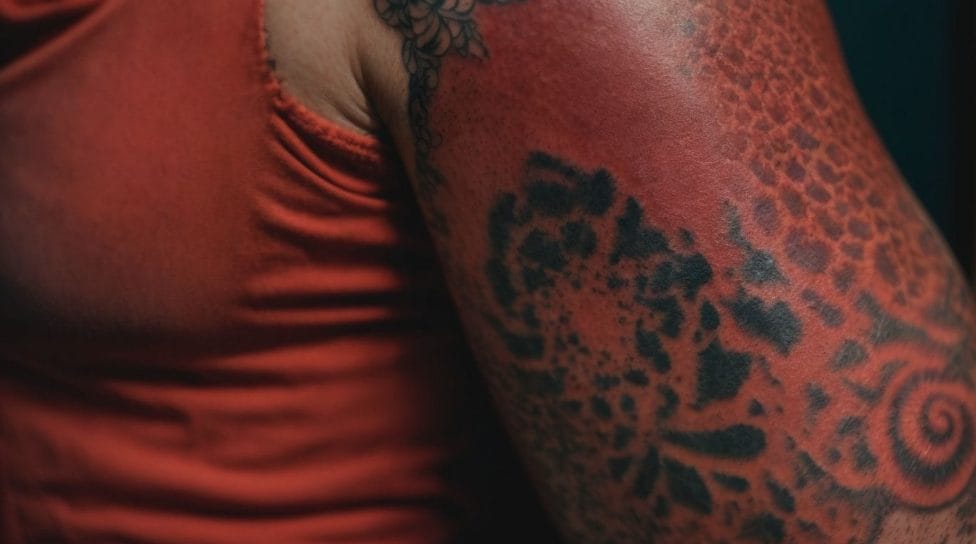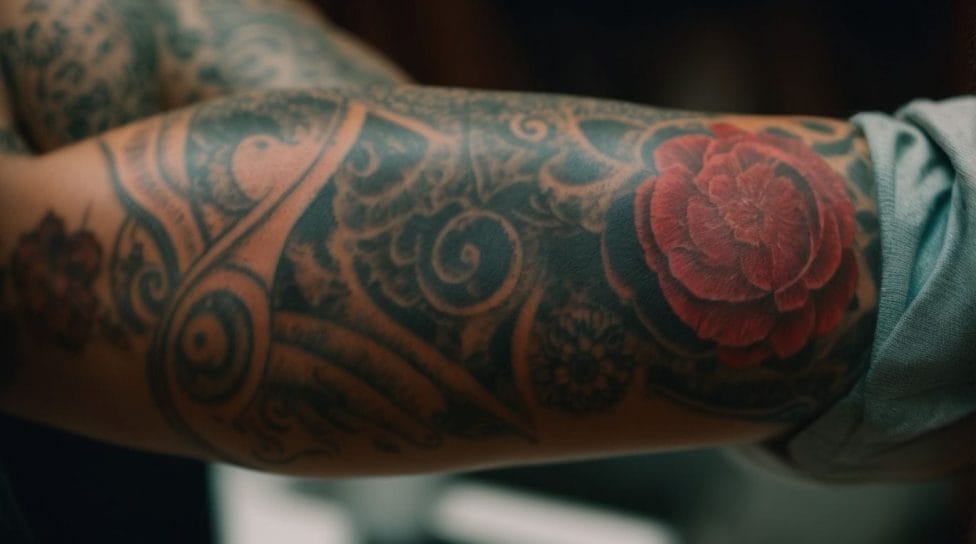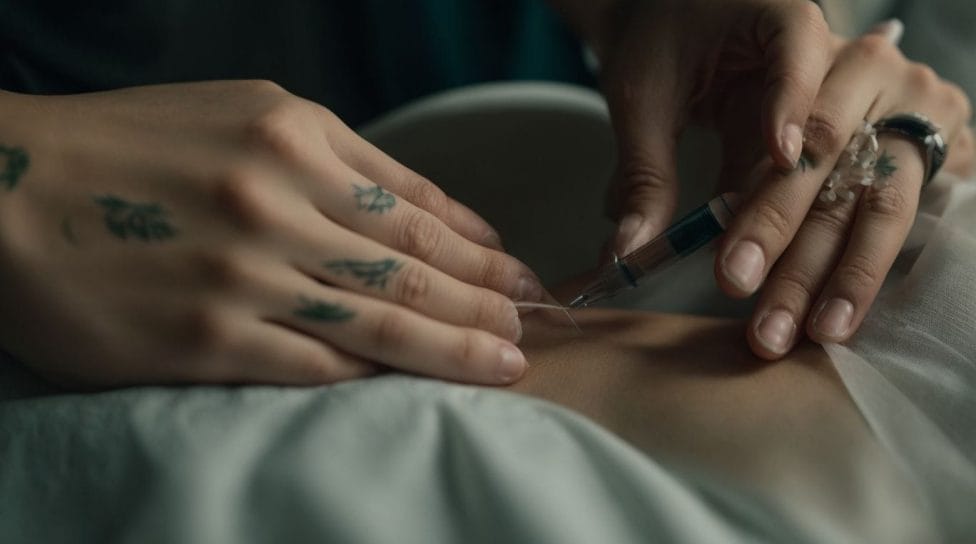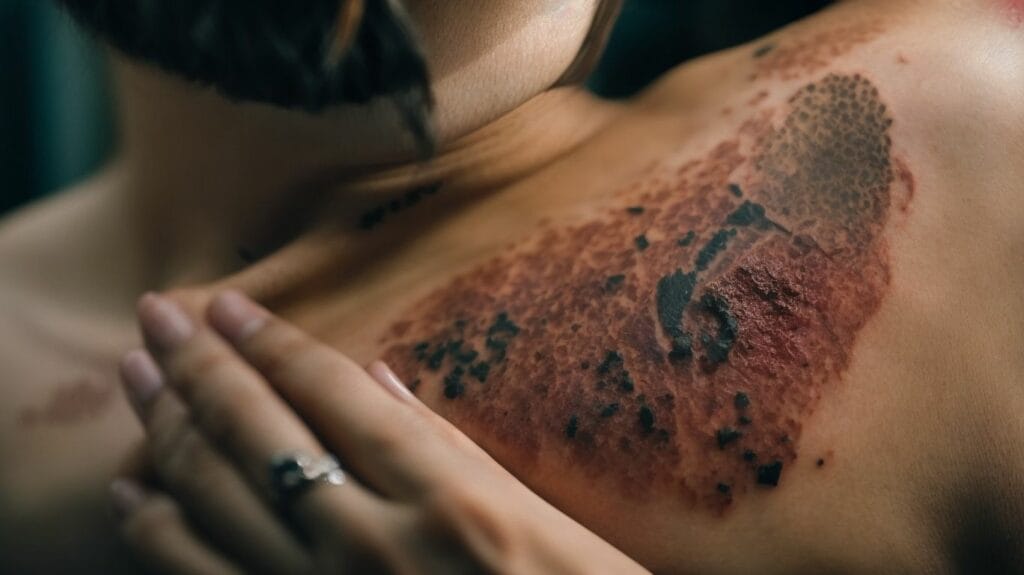Tattoo infections can occur when a tattoo needle penetrates the skin and bacteria or other harmful pathogens enter the wound. Understanding the causes, signs, and potential complications of tattoo infections is crucial for maintaining good tattoo hygiene and ensuring the healing process goes smoothly.
Several factors can contribute to the development of tattoo infections. These include:
- Contaminated Equipment or Environment: If the tattooing equipment or tattoo studio is not properly sterilized, it can introduce bacteria or viruses into the skin.
- Poor Aftercare Practices: Failing to follow proper aftercare instructions, such as not keeping the tattoo clean or not applying the recommended ointments, can increase the risk of infection.
- Allergic Reactions: Some individuals may have allergic reactions to the tattoo ink or other products used during the tattooing process, leading to inflammation and infection.
Recognizing the signs and symptoms of a tattoo infection is crucial for early detection and treatment. Common signs include redness, swelling, pain, and pus or discharge. Other indicators may include fever and chills, as well as increased sensitivity or itching around the tattooed area.
If left untreated, tattoo infections can potentially lead to severe complications, such as cellulitis, abscesses, or even systemic infections. It is essential to address any signs of infection to prevent further complications promptly.
Prevention is key to avoiding tattoo infections. To reduce the risk, it is important to choose a reputable tattoo artist and studio that follows strict hygiene practices. Proper aftercare instructions, including keeping the tattoo clean and moisturized, should be followed diligently. It is also crucial to avoid scratching or picking at the tattoo and be aware of any allergies or skin sensitivities that could lead to infection.
In the event of a tattoo infection, seeking professional treatment is necessary. Treatment options may include antibiotics to address bacterial infections, topical treatments to reduce inflammation and promote healing, and, in severe cases, draining abscesses or surgical intervention.
By understanding the causes, signs, prevention, and treatment of tattoo infections, individuals can ensure a safe and healthy tattooing experience.
Key takeaways:
- Contaminated equipment or environment, poor aftercare practices, and allergic reactions can cause tattoo infections.
- Signs of tattoo infection include redness, swelling, pain, pus or discharge, fever and chills, and increased sensitivity or itching.
- Preventing tattoo infections involves choosing a reputable artist and studio, following proper aftercare instructions, keeping the tattoo clean and moisturized, avoiding scratching or picking at the tattoo, and being aware of allergies or skin sensitivities.
What Causes Tattoo Infections?

Photo Credits: Tattooineplanet.Com by Roger Campbell
Discover the reasons behind tattoo infections in this section. From contaminated equipment and poor aftercare practices to allergic reactions, we’ll delve into the various factors that can cause discomfort and complications after getting inked. Unveiling the truth behind these infection triggers will highlight the importance of proper tattoo hygiene and aftercare habits. So, let’s dive into tattoo infections and gain insights to ensure a safe and enjoyable tattoo experience.
Contaminated Equipment or Environment
Contaminated equipment or environment is a significant cause of tattoo infections. When obtaining a tattoo, it is crucial to ensure that the equipment used is clean and sterilized. Here are some essential points to consider:
- Choose a reputable tattoo artist and studio that prioritizes cleanliness and hygiene.
- Ensure that the needles, ink, and other equipment are properly sterilized.
- Check if the studio follows proper sanitation protocols, such as using disposable gloves and single-use needles.
- Avoid tattooing in unclean or unsanitary environments, as it increases the risk of contamination.
- Regularly clean and disinfect the tattooed area following the aftercare instructions provided by your tattoo artist.
By taking these precautions, you can minimize the risk of infection from contaminated equipment or environment during the tattooing process.
Poor Aftercare Practices
Poor aftercare practices can significantly increase the risk of tattoo infections. To prevent this, it is crucial to follow these steps:
- Listen attentively to your tattoo artist: They will provide detailed instructions on how to take care of your tattoo, including how long to keep the bandage on.
- Maintain clean hygiene: Gently cleanse the tattooed area with mild soap and water, ensure you do not scrub harshly, and then carefully pat it dry with a fresh towel.
- Avoid any rubbing or scratching: It is vital not to irritate the tattooed skin or introduce any potential bacteria into the area.
- Apply the recommended ointment or moisturizer: Follow the specific recommendations of your artist regarding which products to use to keep your tattoo properly hydrated.
- Refrain from exposing the tattoo to excessive moisture: It is important to avoid swimming pools, hot tubs, or soaking in the bathtub until your tattoo is fully healed.
Pro-tip: Always remember that proper aftercare practices are essential for promoting the healing process and effectively preventing infections.
Allergic Reactions
Allergic reactions are one of the causes of tattoo infections, and it is crucial to have awareness about them. Some individuals may experience allergic reactions to the tattoo ink or other materials employed during the tattooing procedure. Signs indicating an allergic reaction may include redness, itching, swelling, or a rash near the tattooed area. To prevent allergic reactions, it is paramount to select a reputable tattoo artist who utilizes high-quality and hypoallergenic ink. Conducting a patch test before getting a tattoo to identify any potential allergies is consistently a wise decision.
Signs and Symptoms of Tattoo Infection

Photo Credits: Tattooineplanet.Com by Philip Moore
Discover the telltale signs that indicate a tattoo may be infected. From redness, swelling, and pain to the presence of pus or discharge, we’ll delve into the common symptoms to watch out for. Learn how fever and chills can also signal an infection and explore the alarming signs of increased sensitivity or persistent itching. Stay informed about the potential risks associated with tattoos and empower yourself to take proactive steps towards a safe and healthy tattoo experience.
Redness, Swelling, and Pain
Regarding tattoo infections, it’s important to know the signs and symptoms, such as redness, swelling, pain, and discomfort. These can indicate that an infection is present and causing pain. If you’re experiencing these symptoms, it’s essential to seek medical attention to prevent further complications and address both redness and pain related to a tattoo infection.
Here are some steps you can take to address both redness, swelling, and pain related to a tattoo infection:
- Keep the area clean and dry to prevent further irritation and pain.
- Apply a cold compress to help reduce swelling, discomfort, and pain.
- Take over-the-counter pain medication, if recommended by a healthcare professional, to alleviate both redness and pain.
- Follow any prescribed antibiotic treatment to combat the infection and relieve pain.
- If the infection persists or worsens, consult with a medical professional for further evaluation and treatment and to address both redness and pain.
Pus or Discharge
Pus or discharge is a common sign of tattoo infection. If you observe any secretion or leakage from your tattooed area, it may indicate an infection. It’s vital to recognize these symptoms and seek suitable treatment promptly. Other indications of infection can include redness, swelling, and pain. To avoid infections, it is imperative to adhere to proper aftercare instructions and maintain the cleanliness and moisture of the tattoo. If an infection occurs, antibiotics or topical treatments may be necessary. It is recommended to consult a healthcare professional to determine the most appropriate action.
Fever and Chills
Fever and chills are common symptoms that may occur if you develop an infection after getting a tattoo. If you notice these symptoms: redness, swelling, and pain at the tattoo site, an infection may occur. Other signs to be cautious about include the presence of pus or discharge, as well as increased sensitivity or itching. It is crucial to seek medical attention if you suspect an infection. Typically, treatment involves the use of antibiotics and topical treatments. To minimize the risk of tattoo infections, it is recommended to choose a reputable artist and studio, follow proper aftercare instructions, maintain cleanliness and moisturization of the tattoo, and refrain from scratching or picking at it. Additionally, it is important to be mindful of any allergies or skin sensitivities that may elevate the chances of developing an infection.
Increased Sensitivity or Itching
Experiencing increased sensitivity or itching around a tattoo may indicate an infection. It is crucial to take action to prevent further complications promptly. Here are the steps you should consider if you notice these symptoms:
- 1. Regularly clean and moisturize the tattoo using mild antibacterial soap and fragrance-free moisturizer.
- 2. Refrain from scratching or picking at the tattoo, as it can introduce bacteria and further irritate the skin.
- 3. Alleviate itching by applying a cold compress or taking over-the-counter antihistamines.
- 4. In case the symptoms worsen or persist, seek consultation from a healthcare professional for accurate diagnosis and treatment with antibiotics or topical ointments.
Remember to adhere to proper aftercare instructions to minimize the risk of infection and ensure the proper healing of your tattoo.
Potential Complications of Tattoo Infections

Photo Credits: Tattooineplanet.Com by Vincent Anderson
- Potential complications of tattoo infections include localized infection, cellulitis, abscess formation, allergic reactions, bloodborne infections, and scarring.
- Localized infection: If bacteria enter the tattooed area, it can cause a localized infection characterized by redness, swelling, and pain.
- Cellulitis: A more serious infection that occurs when bacteria spread beyond the tattoo site, causing redness, warmth, and fever.
- Abscess formation: Pus-filled pockets can develop within the tattooed skin, requiring medical intervention.
- Allergic reactions: Some individuals may be allergic to the tattoo ink, resulting in itching, rash, or hives.
- Bloodborne infections: Unsterile tattoo equipment or contaminated ink can lead to serious bloodborne infections like hepatitis B, hepatitis C, or HIV.
- Scarring: Infection can impair the healing process, leading to the formation of raised or irregular scars.
To minimize potential complications of tattoo infections, ensure your tattoo artist follows proper sterilization techniques, choose reputable studios, and carefully follow aftercare instructions given by your artist. Promptly seek medical attention if you notice any signs of infection.
How to Prevent Tattoo Infections?

Photo Credits: Tattooineplanet.Com by Robert Walker
Protecting your tattoo investment is crucial to maintaining its beauty and preventing unwanted complications. In this section, we’ll dive into essential tips on how to prevent tattoo infections. We’ll explore key steps, including choosing a reputable tattoo artist and studio, following proper aftercare instructions, keeping the tattoo clean and moisturized, avoiding scratching or picking at the tattoo, and being aware of any allergies or skin sensitivities. By implementing these measures, you can ensure that your tattoo stays healthy and vibrant for years.
Choose a Reputable Tattoo Artist and Studio
When choosing a reputable tattoo artist and studio, there are several factors to consider to ensure a safe and satisfying experience.
- Research: Look for artists and studios that have earned a good reputation and garnered positive reviews. Check their portfolios to determine if their artistic style aligns with your vision.
- Cleanliness: It is essential to personally visit the studio to evaluate its level of cleanliness and adherence to proper hygiene practices. It is crucial to verify that the artist utilizes disposable needles and sterilized equipment.
- Licensing: It is crucial to verify that the artist and the studio hold the necessary licenses and comply with local regulations. This guarantees that they meet the required health and safety standards.
- Communication: Schedule a consultation with the artist to discuss your design, expectations, and any concerns you might have. A reputable artist will attentively listen to your needs and be open to discussion.
- Portfolio: Assess the artist’s portfolio to evaluate the quality of their work. Look for precise lines, vibrant colors, and meticulous attention to detail.
Follow Proper Aftercare Instructions
- It is essential to follow proper aftercare instructions to prevent tattoo infections and promote proper healing.
- To keep the tattoo clean, gently wash it with mild soap and lukewarm water, removing bacteria or debris.
- For moisturizing and preventing dryness and cracking, apply a recommended ointment or lotion.
- Please resist the urge to scratch or pick at the tattoo, which can introduce bacteria and lead to infection.
- To prevent color fading and prolong the healing process, avoid exposing the tattoo to direct sunlight.
- Choose loose and breathable clothing options to prevent friction and irritation on the tattooed area.
Remember to follow the specific aftercare instructions provided by your tattoo artist for optimal healing. If you observe any signs of infection, such as excessive redness, swelling, or pus, seek immediate medical attention.
Keep the Tattoo Clean and Moisturized
To keep the tattoo clean and moisturized, it is important to follow these steps:
- Before touching your tattoo, ensure that you thoroughly wash your hands.
- Gently cleanse the tattoo with lukewarm water and a mild, fragrance-free soap.
- Avoid rubbing and, instead, pat the tattoo dry using a clean and soft towel.
- For proper aftercare, apply a thin layer of hypoallergenic and fragrance-free ointment designed for tattoos.
- Repeat cleaning and moisturizing your tattoo 2-3 times a day.
- To prevent damage and fading, avoid exposing your tattoo to excessive moisture like swimming or hot tubs.
- Protect your tattoo from direct sunlight or tanning beds to maintain its vibrancy and prevent any harm.
- Wearing loose clothing in the tattooed area will prevent friction and irritation.
By keeping your tattoo clean and moisturized, you can effectively prevent infections and promote proper healing. Additionally, this will help preserve the longevity and vibrancy of your tattoo.
Let me share a true story: Sarah diligently followed the steps to keep her tattoo clean and moisturized after getting it. She religiously used the recommended aftercare products and strictly followed the cleaning routine. As a result, Sarah’s tattoo healed beautifully without complications, allowing her to enjoy her new artwork for many years.
Avoid Scratching or Picking at the Tattoo
Avoid scratching or picking at a tattoo, which can lead to serious complications and delay the healing process. It is crucial to resist the urge to scratch or pick at the tattoo to avoid the following risks:
| 1. Infection: | Scratching or picking can introduce bacteria to the open wound, increasing the risk of infection. |
|---|---|
| 2. Scarring: | Aggressive scratching or picking can damage the delicate skin and lead to excessive scarring. |
| 3. Fading or Distortion: | Picking at scabs or peeling skin can cause the ink to be removed prematurely, leading to fading or distortion of the tattoo. |
| 4. Delayed Healing: | Constant irritation from scratching can delay the healing process, leading to prolonged discomfort and potential complications. |
To prevent these issues, it is important to keep the tattoo clean and moisturized and follow proper aftercare instructions provided by the tattoo artist.
Be Aware of Any Allergies or Skin Sensitivities
When getting a tattoo, you must know about allergies or skin sensitivities. This is to ensure a safe and successful tattoo experience and prevent any complications. Before getting a tattoo, it is important to inform your tattoo artist about any allergies or sensitivities you possess, such as allergies to specific metals or skin conditions like eczema. They can make necessary adjustments or use hypoallergenic ink to avoid potential reactions. Taking a proactive approach and being knowledgeable about your body’s sensitivities is essential to prevent any discomfort or complications during the tattooing process.
How Are Tattoo Infections Treated?

Photo Credits: Tattooineplanet.Com by Arthur Wright
When it comes to taking care of your tattoo, understanding how infections are treated is crucial. In this section, we will explore the various methods used to address tattoo infections. From antibiotics to topical treatments and even drainage of abscesses, we’ll dive into the different approaches professionals take to ensure your tattoo heals safely and effectively. So, if you’re curious about the ins and outs of tattoo infection treatment, keep reading for all the important details.
Antibiotics
Antibiotics are commonly used to treat tattoo infections, helping to eliminate the bacteria causing the infection and promote healing.
- Oral antibiotics: Prescribed to treat moderate to severe infections, such as cellulitis or abscesses.
- Topical antibiotics: Applied directly to the infected area to prevent the spread of bacteria and promote healing.
- Combined treatments: In some cases, oral and topical antibiotics may be combined for more effective treatment.
It’s important to follow the prescribed course of antibiotics and complete the full treatment to ensure the infection is completely eradicated. History shows that antibiotics have revolutionized the treatment of bacterial infections, saving countless lives and improving healthcare globally.
Topical Treatments
Topical treatments can be highly effective in the treatment of tattoo infections and in promoting the healing process. Presented below are some commonly used options for topical treatments:
- Antibacterial ointments: To prevent further infection, it is advisable to apply a thin layer of a reliable antibacterial ointment, such as Neosporin, to the infected area.
- Topical antibiotics: Healthcare professionals often prescribe creams or ointments to combat bacterial infections.
- Hydrocortisone cream: When dealing with infected tattoos, utilizing hydrocortisone cream can effectively reduce both inflammation and itching.
- Aloe vera gel: Applying aloe vera gel can soothe the infected area while also promoting the healing process.
- Tea tree oil: Known for its antimicrobial properties, it can aid in fighting off infections and facilitating healing.
It is important to remember that if the infection does not improve or worsen despite using topical treatments, immediate medical attention should be sought. Pro-tip: Always consult a healthcare professional before administering topical treatment on an infected tattoo.
Drainage of Abscesses
Drainage of abscesses is an essential and significant step in treating tattoo infections. To ensure optimal drainage, please follow these natural and straightforward steps:
- Start by maintaining proper hygiene, which involves thoroughly washing your hands with soap and water.
- Create a clean and sterile environment using pristine towels, gloves, and sterilizing tools.
- Clean the infected area with an antiseptic solution to remove debris or bacteria.
- Utilize a sterile needle or scalpel to make a small incision precisely at the site where the abscess is located.
- With gentle pressure, facilitate the drainage of pus and other infectious materials surrounding the abscess.
- Once the abscess has been drained, carefully cleanse the area and apply antibiotic ointment.
- Safeguard the area from further contamination by covering it with a sterile bandage.
- Monitor the healing progress vigilantly and promptly seek medical attention if any signs of a deteriorating infection or complications arise.
Some Facts About How Tattoos Get Infected:
- ✅ The biggest concern people have before and after getting a tattoo is the risk of infection. (Source: Our Team)
- ✅ There are five common ways tattoos typically get infected: unsanitary tattoo shops, mistakes in the first 24 hours, not following aftercare instructions, engaging in certain activities too soon, and traveling too soon. (Source: Our Team)
- ✅ Neglecting aftercare instructions and exposing the tattoo to harmful bacteria are common mistakes made on the first day after getting a tattoo. (Source: Our Team)
- ✅ Following the aftercare instructions provided by the tattooist for at least three weeks and scheduling a follow-up inspection are important for preventing infection. (Source: Our Team)
- ✅ Prioritizing immediate aftercare, including recommended cleaning solutions and moisturizers, is crucial for protecting the tattoo and preventing infection. (Source: Our Team)


